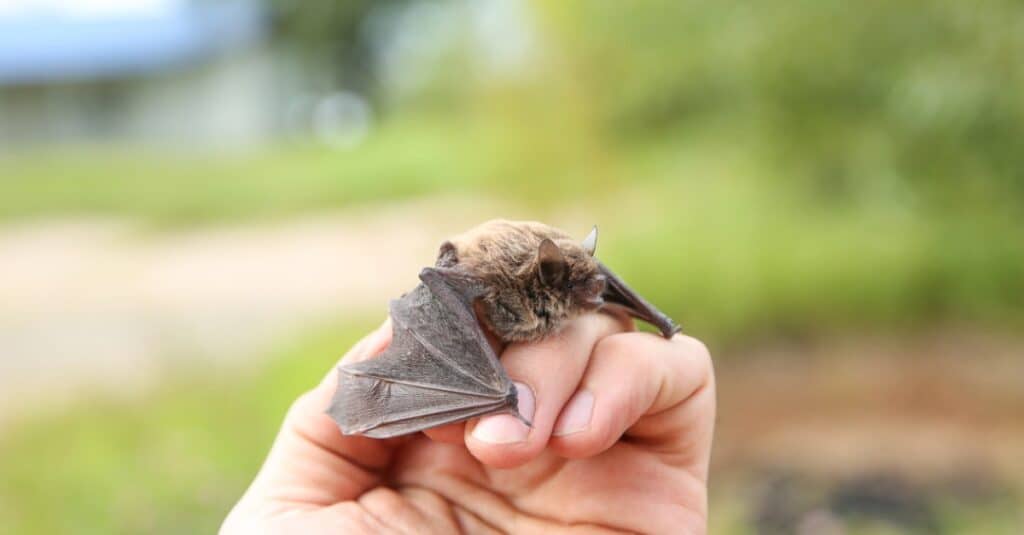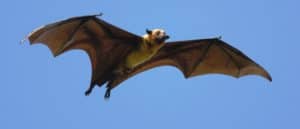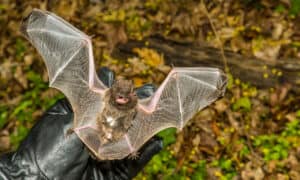Bats may be born blind, but they’d don’t stay that way. Around 1 to 2 weeks of age, they begin to open up their tiny eyes and take in the world around them. But even though they can see, bats rely on their other senses more heavily when taking flight. And they’re the only mammals capable of sustained flight.
Since bats are warm-blooded mammals, they give birth to live young and nurse them with milk. They even build or establish nurseries for birthing. Instead of a nest, bats use these maternity roosts as a haven to raise their young. Once the babies grow up, they can live for 30 years or longer.
When do bats have babies? Follow along to find out!
When Do Bats Have Babies?

Baby bats weigh less than .1oz.
©iStock.com/Petr Smagin
Bats have babies between May and July. Most species give birth to one baby per year.
A baby bat called a pup, is only 1 to 2 inches at birth, and they weigh around .1 oz. When they enter the world, bats are furless and blind for the first one to two weeks of life. Their tiny pink bodies are covered in fine hair, and they make high-pitched squeaking sounds. Some say they sound like a squeaky toy or bird tweeting.
Similar to human babies, bat babies babble and repeat sounds they hear. This helps them learn how to communicate. Baby bats will wail if they’re orphaned. And they also protest if their mom leaves the roost, which is a nightly occurrence.
Nighttime is feeding time for bats, but that doesn’t always mean the baby is left alone. Sometimes bat moms take their pups with them out on the hunt.
Flying out of the roost, a bat mom will carry her young on the underside of her body. The baby grips its leg and teeth during these nighttime flights.
Although cute, baby bats must be approached with caution. If you see a baby bat or a fully grown bat, don’t pick it up with your bare hands. Instead, use gloves or a container. All bats carry the risk of rabies, so admiring them without interfering with their life is always a good approach.
Where Do Bats Have Babies?

Sometimes bats create maternity roosts in attic spaces.
©Hermann Moller/Shutterstock.com
How long are bats pregnant? The answer varies among species, as well as different environmental factors. Generally, under favorable conditions, bat pregnancy lasts six to nine weeks.
Bats have babies in maternity roosts. These havens are usually dry, warm places and are usually formed in early summer. Pregnant females are responsible for establishing a suitable nursery and forming a colony.
Sometimes bats use a hollow tree or cave as a nursery. Other times they inhabit buildings, taking refuge in roof spaces. They do their best to pick a location that will remain undisturbed while still providing access to insect-rich habitats.
A roost may start off with one or two females, but it doesn’t stay that small. As the summer continues, the number of females in the roost will grow. Sometimes they even return to the same nursery the next year, especially if it’s a good spot.
How Many Babies Does a Mother Bat Have?

Most bat species give birth to one pup per year.
©Corina Daniela Obertas/Shutterstock.com
Bats give birth to one pup per year. At least most species do. A few species, like the eastern red bat, usually have twins.
Around late June or early July, female bats give birth to a single baby. A baby can that mother can identify by smell and sound. The mother bats suckle their blind, furless babies her milk. After several weeks of nursing, the young bats begin to grow at a rapid rate.
Bat babies soon become able to fly, learn to echolocate, and catch their own prey. They become independent by 6-7 weeks after birth.
In August, the females leave the maternity roost to build up body fat in preparation for winter. They plump up by feeding on late summer insects.
Have you ever seen a bat eating before? It’s pretty bizarre looking. Bats use their wingtips to push insects into their tail membrane. Then they grasp the prey with their teeth.
Even though they just gave birth, females are quick to find a mate again. Females seek out males who have established mating territories by mid-August. Mating takes place from August onwards. After mating, the female retains the sperm but doesn’t become pregnant. Instead, she holds on to the sperm, and then after hibernation, pregnancy occurs.
Bat Moms: Tree Bat vs. Hibernating
Not all bat moms raise the young the same way. A pup’s introduction into the world varies greatly depending on if it’s a tree bat or hibernating bat.
Tree bat pups are more precocial, meaning they’re born in a more mature state. In other words, tree bat pups are big babies! These large babies are born well-developed and with fur.
In contrast, hibernating bat pups are more altricial. You can check out the exact differences between precocial vs. altricial species here. Hibernating bats are born hairless and rely on their mothers for warmth and protection from predators (see what eats bat’s here).
Tree bat pups can fly within a few weeks after birth and become independent relatively quickly. Bu hibernating bat pups need a bit more help. These bat babies take longer to develop flying skills, which means it’s a while before they become independent.
To tell these bats apart at a glance, notice their color. Tree bats have varied fur colors, while most hibernating bats have dark brown fur.
The Nursing Behavior and Care of Baby Bats

Bats are warm-blooded mammals; they nurse their young.
©iStock.com/Connie Kerr
Tree bats give birth and raise their young in tree roosts or foliage. These bat moms form maternity colonies during the summer. They use these colonies to give birth and raise their pups.
Tree bat pups are usually born in late spring or early summer. The pups are born relatively large, but that doesn’t stop their moms from bringing them on nightly flights. The mother bat carries her pup with her and nurses it.
Hibernating bats have a different reproductive strategy than tree bats. But they share a lot of similarities when it comes to birthing and raising their young. Female hibernating bats also form maternity colonies during the summer to give birth and raise their young.
Hibernating pups are born hairless and relatively underdeveloped. They rely on their mothers for warmth, food, and protection. Sometimes their moms will take them on a nightly hunt; other times, they leave their tiny pups in the roost to rest. Overall hibernating bat pups have a longer dependency and maturation than tree bat pups. Tree bat pups are fairly independent by six weeks, but hibernating pups can take several months to grow up.
How Baby Bats Learn to Fly

Pups have to learn how to flap their wings and use echolocation before taking flight.
©iStock.com/phototrip
In the animal kingdom, many baby animals rely on their parents to learn how to walk. And in the bat world, it’s the mother’s job to teach her young to fly. A task that’s a lot trickier than you might think.
Bats fly using echolocation. This means pups not only have to master the art of flying but also the advanced skill of echolocation. Before they can even attempt to take off, a pup must know how to navigate.
When they’re around five to six days old, pups begin flapping their wings. And they do this somewhat awkwardly. It takes a little while before they can produce a controlled flap. It’s around this time that they also begin learning how to string together landing buzzes, a type of echolocation skill.
Despite these big accomplishments, wing flapping, and land buzzing, the tiny pups still have a long way to go. To fly smoothly, a pup must learn how to coordinate its cries with flight. Baby bats, whose wings grow fast, are usually the first to fly. And once they can fly, they’re almost completely independent.
How Baby Bats Learn to Talk

Bats use echolocation to hunt their prey.
©Rudmer Zwerver/Shutterstock.com
How do baby bats learn to talk? By listening to the grownups around them.
Bats are one of the few mammal groups known for vocal learning. Pups repeat noises made by others to communicate. To illustrate, baby Egyptian fruit bats learn calls from their mothers. And they can also learn new dialects from the colony members around them. Luckily for these bat babies, there are plenty of learning opportunities. Egyptian fruit bats are highly social animals. They live in colonies with dozens to thousands of other bats.
Bats are becoming an important species for studying vocalization in mammals. In one study, researchers experimented with pregnant Egyptian fruit bats. They wanted to see exactly how pups learn dialects. The study involved separating the mothers into different chambers and playing recordings of different pitches. And what did they find out?
After growing up with specific pitch recordings, young bats mimicked the pitch of their surroundings. This helped prove that baby bats naturally pick up vocalizations from the animals around them. A skill they likely evolved to have because of their dark and noisy environment.
Moving forward, more studies are in the works to see how the dialect of young bats changes as they leave the roost. Do they still talk the way they were raised? Or do they adopt new dialects when they’re on their own? As more studies take place, we may know soon. And these findings can help us understand even more about ourselves. Studying vocal learning in bats can provide insights into how humans learn language.
What to Do if You Find a Baby Bat

If you find a baby bat, its mother may be nearby.
©NivCube/Shutterstock.com
What should you do if you find a baby bat? See if the mother or roost is nearby before interfering. If the baby is on the ground, put on gloves and then help it into a nearby tree. If the pup can grip the bark, it’ll be able to safely wait for its mother to return.
You can also contact a licensed wildlife rehabilitator or local veterinary center for assistance. For instance, if a baby bat is separated from its mother, call the professionals.
If a baby bat is found inside your property, contain it in a lidded container with breathing holes. Then call professional help. You may need to get advice from a bat removal company, too, since a baby bat could be a sign of a maternity colony on your property.
Bat poop is another give away there might be a colony. Look for humane removal services that can offer you the latest tips for securing your land without harming the bats. Bats are amazing creatures with in-depth symbolism and cultural meanings worldwide. instead of fearing them, let the professionals help you find a safe solution.
Hoary Bat Babies

Hoary bat pups weigh about .14 oz at birth.
©Photographer: Frank Bonaccorso, USGS / public domain – License
Hoary bats are the biggest bats in New York. They weigh up to seven times more than other bat species. Their breeding takes place in late summer or early fall. Eggs aren’t shed to ovaries until spring. As a result, hoary bat babies enter the world between mid-May and early July. And unlike most cave bats, these species can have two to four offspring at a time. It’s more common for them to have two pups, but four is possible.
Hoary bat pups are also born blind and weigh about .14 oz. The babies cling to their mom all day long and don’t start flying on their own until they’re about one month old. Around this time, the young can begin hunting for their own food, which includes bugs and occasionally other bat species. If you see a hoary bat, consider yourself lucky. These bats are rarely ever seen by humans. They occur in small numbers and don’t like entering human structures.
Little Brown Bat Babies
Little brown bats, one of the fastest bat species, usually mate during the fall but occasionally in winter and spring. Like many other species, the females store the sperm, waiting to become pregnant. They’ll store the fertilized egg throughout the entire hibernation.
Around the spring or summer, females begin forming maternity roosts. These roosts can be in hollow trees, cliff crevices, or loose tree bark. They’ll even take refuge in undisturbed parts of buildings. Once they become pregnant, gestation lasts 50 to 60 days.
Little brown bat pups are born in May or June. They, too, are blind and lack fur. The young are weaned as soon as six weeks of age and can begin flying by three to four weeks.
Mexican Free-Tailed Bat Babies

Mexican free-tailed bats have large maternity roosts with 500 pups per square foot.
© – License
Mexican free-tailed bats form maternity colonies in the early spring. Mother gives birth to one pup each in June. A single colony can have up to 500 pups per square foot.
These single-child pups feed on their mother’s rich milk, allowing them to grow quickly. Within four to five weeks, they’re already set for flight. By early August, most pups are flying and foraging on their own. And they’re super fast flyers.
Mexican free-tailed bats are made for speed with short fur and long narrow wings. They can fly over 60 miles round-trip in an evening while foraging for insects. Sometimes, they fly two miles high to catch the perfect bugs.
Around October to mid-November, the new adults begin migrating to prepare for the winter. They spend winters cozied up in the caves in Mexico.
Baby Bats in Washington

Sometimes baby bats attach to their mothers, coming along for their nightly flight.
©iStock.com/tane-mahuta
Most Washington bats breed during late fall or winter. And they do this at their hibernation site. Similar to other species, females store sperm until the following spring, when fertilization takes place.
Attics are a popular spot for bats in Washington since they keep mothers and pups nice and warm. Nursery colonies are only occupied by breeding females and their young. Which means males are left to roost alone or in small groups.
Most bat species in Washington produce one pup in May, June, or July. The tiny pups remain with their mothers, unable to fly for their first month of life. When they’re finally ready to leave the roost, the young remember their birthplace. Female bats may return to the exact location where they were born year after year.
The photo featured at the top of this post is © iStock.com/Ondrej Prosicky
Thank you for reading! Have some feedback for us? Contact the AZ Animals editorial team.






